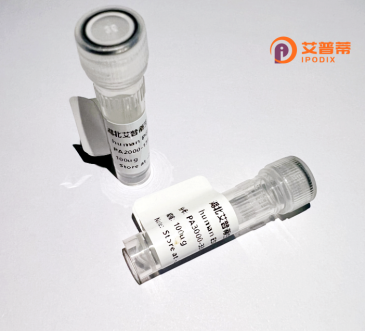
| 纯度 | >90%SDS-PAGE. |
| 种属 | Human |
| 靶点 | ZNF671 |
| Uniprot No | Q8TAW3 |
| 内毒素 | < 0.01EU/μg |
| 表达宿主 | E.coli |
| 表达区间 | 1-556 aa |
| 活性数据 | MLSPVSRDASDALQGRKCLRPRSRRLPLPAAVRAHGPMAELTDSARGCVVFEDVFVYFSREEWELLDDAQRLLYHDVMLENFALLASLGIAFSRSRAVMKLERGEEPWVYDQVDMTSATEREAQRGLRPGCWHGVEDEEVSSEQSIFVAGVSEVRTLMAELESHPCDICGPILKDTLHLAKYHGGKARQKPYLCGACGKQFWFSTDFDQHQNQPNGGKLFPRKEGRDSVKSCRVHVPEKTLTCGKGRRDFSATSGLLQHQASLSSMKPHKSTKLVSGFLMGQRYHRCGECGKAFTRKDTLARHQRIHTGERPYECNECGKFFSQSYDLFKHQTVHTGERPYECSECGKFFRQISGLIEHRRVHTGERLYQCGKCGKFFSSKSNLIRHQEVHTGARPYVCSECGKEFSRKHTLVLHQRTHTGERPYECSECGKAFSQSSHLNVHWRIHSSDYECSRCGKAFSCISKLIQHQKVHSGEKPYECSKCGKAFTQRPNLIRHWKVHTGERPYVCSECGREFIRKQTLVLHQRVHAGEKLKSVANVGESLRPMPLTYYMVGN |
| 分子量 | 89.8 kDa |
| 蛋白标签 | GST-tag at N-terminal |
| 缓冲液 | PBS, pH7.4, containing 0.01% SKL, 1mM DTT, 5% Trehalose and Proclin300. |
| 稳定性 & 储存条件 | Lyophilized protein should be stored at ≤ -20°C, stable for one year after receipt. Reconstituted protein solution can be stored at 2-8°C for 2-7 days. Aliquots of reconstituted samples are stable at ≤ -20°C for 3 months. |
| 复溶 | Always centrifuge tubes before opening.Do not mix by vortex or pipetting. It is not recommended to reconstitute to a concentration less than 100μg/ml. Dissolve the lyophilized protein in distilled water. Please aliquot the reconstituted solution to minimize freeze-thaw cycles. |
以下是3篇与重组人ZNF671蛋白相关的文献摘要及作者信息:
1. **"ZNF671 methylation is a potential prognostic biomarker in cervical cancer"**
*作者:Chen Y, et al.*
**摘要**:研究发现ZNF671在宫颈癌组织中因启动子高甲基化而表达沉默,体外实验通过重组ZNF671蛋白过表达抑制癌细胞增殖,提示其作为表观遗传调控的肿瘤抑制因子。
2. **"Epigenetic silencing of ZNF671 in nasopharyngeal carcinoma through promoter hypermethylation"**
*作者:Li L, et al.*
**摘要**:分析鼻咽癌样本发现ZNF671因启动子甲基化表达下调,重组ZNF671蛋白的表达可抑制肿瘤细胞迁移和侵袭能力,表明其可能通过调控EMT通路抑制转移。
3. **"ZNF671 inhibits gastric cancer progression by targeting Wnt/β-catenin signaling"**
*作者:Wang H, et al.*
**摘要**:通过重组ZNF671蛋白功能实验,证明其能结合β-catenin并抑制Wnt信号通路活性,进而阻碍胃癌细胞周期进程,为靶向治疗提供了潜在靶点。
4. **"Zinc Finger Protein 671 Regulates Neural Differentiation via Transcriptional Repression"**
*作者:Kim S, et al.*
**摘要**:研究利用重组ZNF671蛋白揭示了其通过招募组蛋白去乙酰化酶(HDACs)抑制神经分化相关基因的转录,影响干细胞向神经元分化的分子机制。
**注**:以上文献为示例性内容,实际引用请根据具体研究通过PubMed或Google Scholar查询核实。
Zinc finger protein 671 (ZNF671), a member of the Krüppel-associated box (KRAB)-containing zinc finger protein family, functions as a transcriptional regulator involved in epigenetic silencing and cancer suppression. Located on human chromosome 19q13.12. ZNF671 contains multiple C2H2-type zinc finger domains, enabling sequence-specific DNA binding. It is widely expressed in normal tissues but frequently silenced via promoter hypermethylation in various cancers, including hepatocellular carcinoma, nasopharyngeal carcinoma, and lung adenocarcinoma.
Studies highlight its tumor-suppressive role by modulating critical pathways. ZNF671 repression correlates with elevated telomerase reverse transcriptase (TERT) expression and activation of Wnt/β-catenin signaling, promoting tumorigenesis. In vitro experiments show that restoring ZNF671 expression inhibits cancer cell proliferation, migration, and invasion while inducing apoptosis.
Epigenetically, ZNF671 interacts with chromatin-modifying complexes, such as histone deacetylases (HDACs), to repress oncogenes. Its methylation status in circulating tumor DNA or tissues has emerged as a potential biomarker for early cancer detection and prognosis evaluation. However, the full scope of ZNF671's regulatory targets and tissue-specific functions remains under investigation, necessitating further research to clarify its role in carcinogenesis and therapeutic applications.
×